
In this third Sport Fishing reader knot challenge, we wanted to see how anglers choose to connect their main line directly to terminal gear. That is, without using a leader, what knot would they use to tie their line directly to a hook or lure?
Not all anglers — or professional skippers (see 10 Reasons Pros Don’t Use a Leader) — bother with a leader. For various reasons, some anglers never tie directly, but many do skip the leader at times, depending upon the situation.
What defines a “good” knot? The ease and speed with which a knot is tied are important, but nothing trumps strength. And, ultimately, 100 percent knot strength is the ideal. That means that the knot you tie breaks at about the same point at which the line itself breaks.
All knots are hardly created equal. While most challenge entrants expressed great faith in their knots, in fact, many would seem to be cheating themselves of considerable strength: Mono knots varied from 75 to 100 percent; braid knots varied from 31 to 87 percent.
Clearly, fishing knots matter.
About The Fishing Knot Challenge
We tested 29 mono knots and 30 of the best knots for braided line. (A few additional entries were received but not tested since failing to follow directions rendered them ineligible.)
Entrants received a package containing a length of 20-pound Hi-Seas Grand Slam mono and a length of 20-pound PowerPro braid, along with a half-dozen Berkley McMahon swivels. They were instructed to tie the same knot with mono onto three swivels, and with braid onto the other three.
We allowed anglers the option to tie a double line first, with a Bimini twist or any other knot used to create a double line, and then tie the double line to the swivel.
Why not restrict entrants to using a single line? The whole point of this challenge was to offer insight into the strongest connections you can choose — so you tie your main line directly to your terminal gear in the strongest way possible. If doubling the line gives you an edge, we want you to know.
That said, we also stipulated to anglers choosing to tie a double line to their terminal gear that we would test both the double-line knot (typically the Bimini) as well as the terminal knot, and the weaker of the two would be counted in this test.
After all, that, again, is the point: to measure the strength of your connection.
We tested lines, as in past challenges, courtesy of the International Game Fish Association, on the same Instron 5543 electromechanical tension tester that the IGFA uses to determine the strength of lines submitted with world-record applications.
Initially, via the Instron, we ran tensile tests of just the lines to determine the breaking point for the 20-pound Grand Slam mono (27.04 pounds) and the 20-pound PowerPro braid (41.45 pounds).
Then we tested each knot at the swivel and noted the mean break (over three tests of each knot), as well as the consistency of those breaks (via the standard deviation).
The mean break point was then calculated against the line’s tensile strength to show at what percentage of the line’s strength the knot broke. That figure determined the relative standing of each knot in the test.
Note that the mono was tested dry. That means that results throughout would have been slightly less had it been soaked before testing. However, what’s most important is that the results should have still been relatively the same.
 |
Subscribe Now and Save 81% |
Results and Conclusions

Among 29 entries, the strongest mono knots were pretty well distributed from 100 percent down to about 72 percent, with five finishing from 72 to 75 percent, but most knots breaking in the 80s.
Previous line and knot tests in SF have confirmed that good knots in mono should entail little or no loss in strength. Here, the three winning knots broke at or very close to 100 percent.
Even knots that proved weaker weren’t dismally so; still, what would you rather have connecting your hook to that once-in-a-lifetime trophy? A knot that will give you 99 or 100 percent of the line’s strength? Or a knot that will break at 72 percent of the line’s strength?
Your fishing knot matters.
HOW TO TIE THE WINNING MONO KNOT (100%)
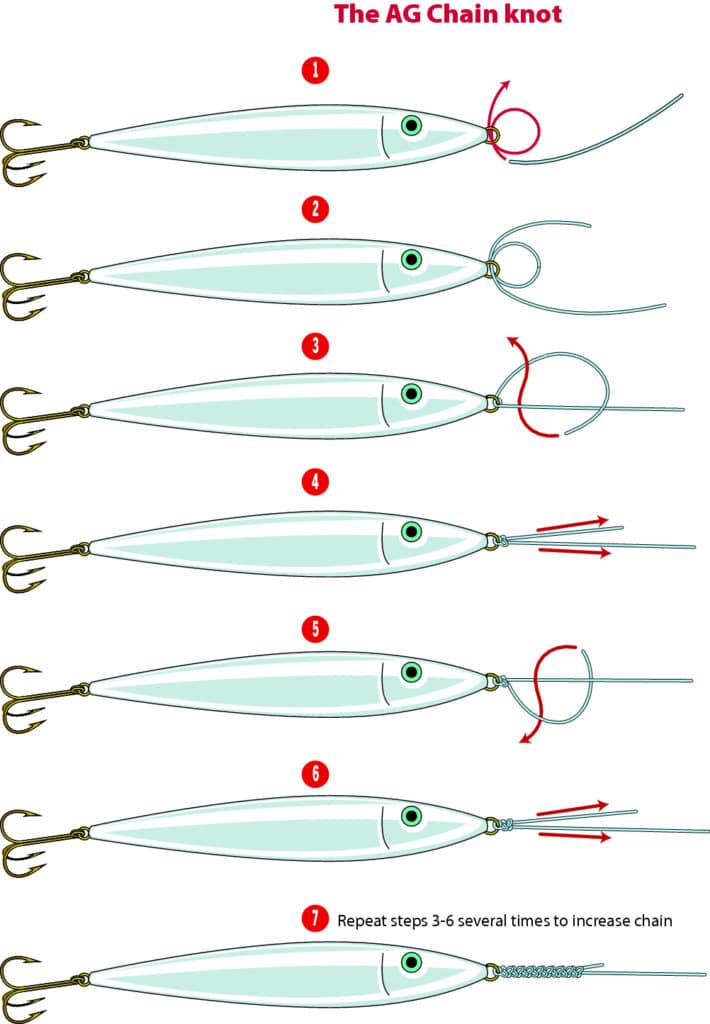
Joel Blessing's AG chain knot came out on top. (In fact, it broke at barely over 100 percent of the line's strength, attributable presumably to variation in the line. (I have observed this phenomenon previously, with line seeming to inexplicably slightly gain strength from knots.) The knot — which is also one of the most consistent — does take a bit of time to tie.
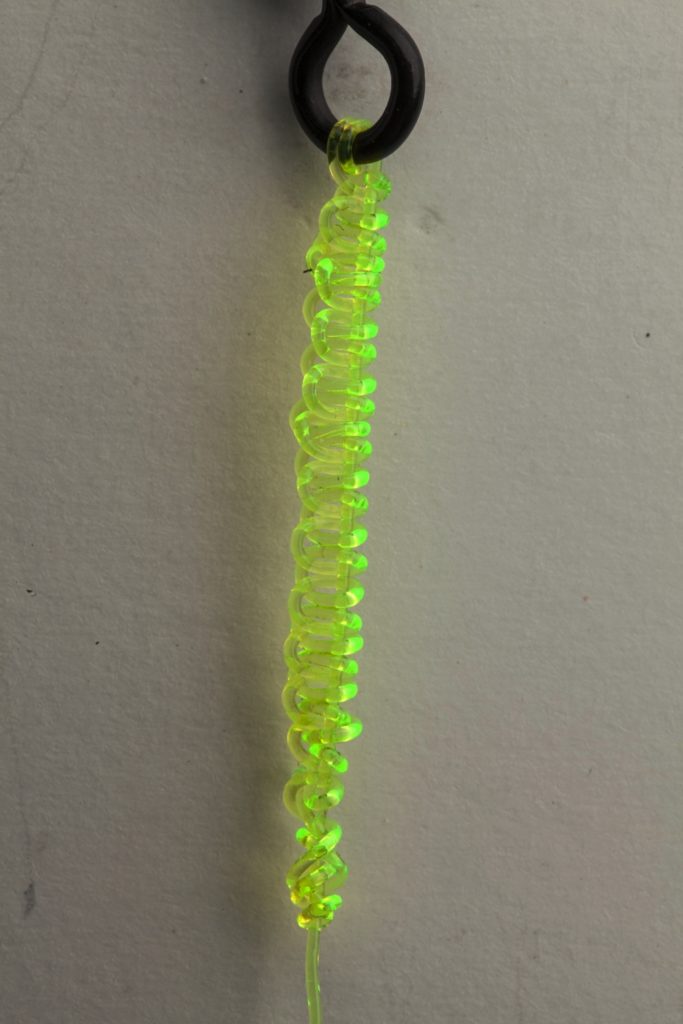
HOW TO TIE THE SECOND-PLACE MONO KNOT (99.26%)

It would seem that if you don’t mind giving up about a mere pound of strength, a standard five-turn uni knot as tied by Brian Helms of Sarasota, Florida, would be quicker to tie than the AG chain knot.
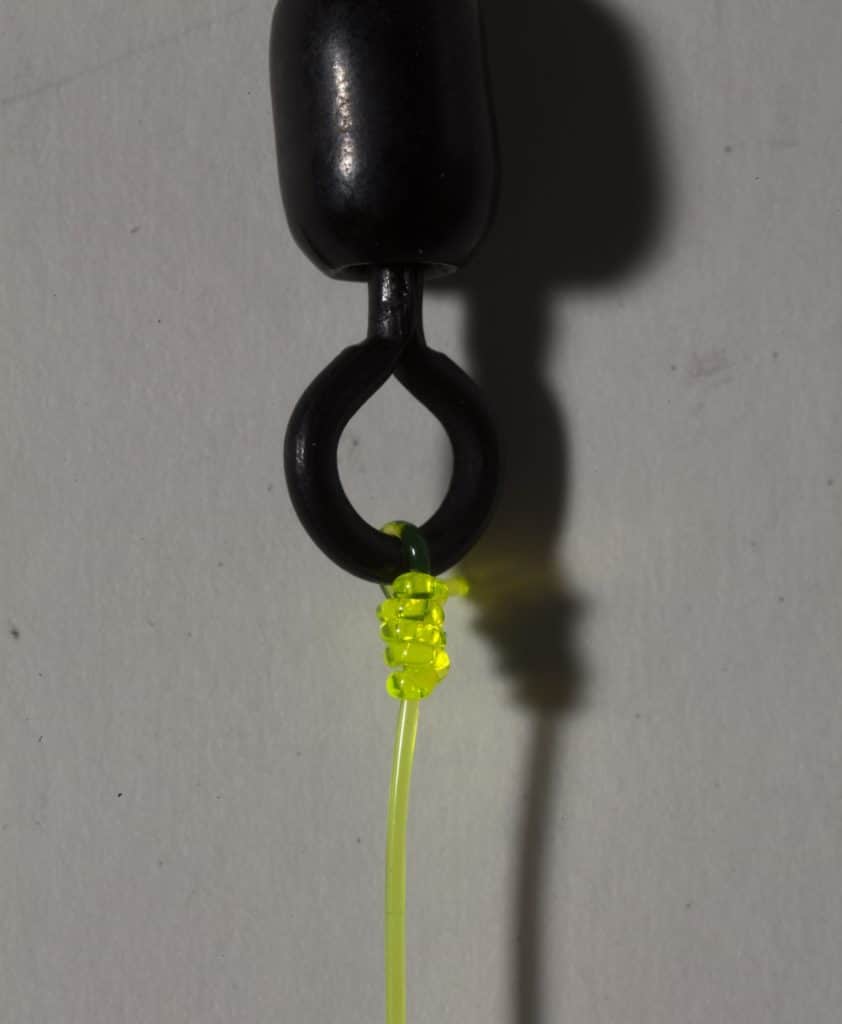
HOW TO TIE THE THIRD-PLACE MONO KNOT (98.71%)

This simple knot proved very effective. The entrant says he learned it "from an old fisherman from Lafayette (Louisiana)."
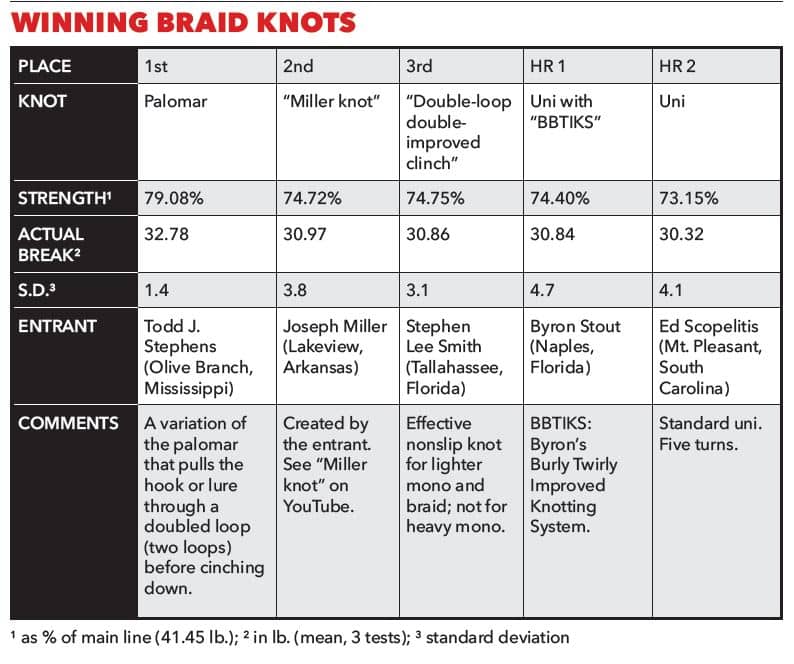
As shown in the table above, no braid knot managed to yield as much as 80 percent of the line’s strength. However, a knot that breaks as low as 67 percent or so in 20-pound braid still offers as much actual strength as a 100 percent mono knot. That’s because braid is so much stronger to start with; the 20-pound braid broke at more than 41 pounds, versus 27 for mono.
HOW TO TIE THE WINNING BRAID KNOT (79.08%)

Among the 30 braid knots in this challenge, the best terminal knot to connect a single main line to terminal gear was a palomar, but with a twist. Winner Todd Stephens doubled the usual loop to create two loops, which he passed through the eye of his terminal gear before tying an overhand knot in both loops and pulling his terminal gear through that. The result was a knot just shy of 80 percent of the line’s strength.
This would seem to be the best way to tie a palomar; other palomar entries, tied with the traditional single loop, fared less well.
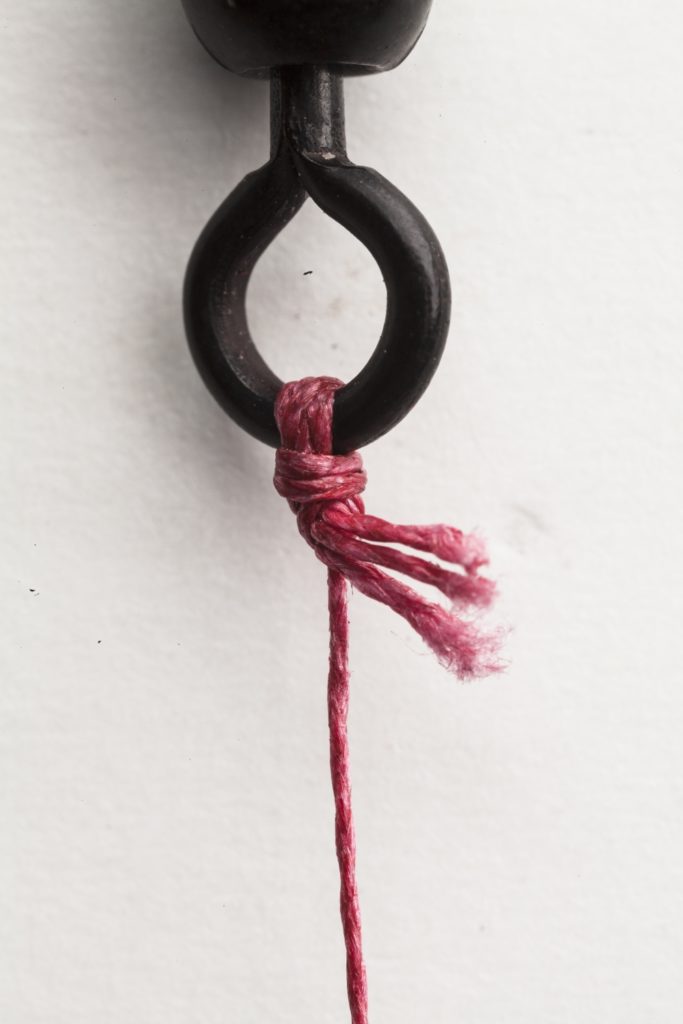
Many variations of knots were submitted. Many would take more time to tie than the simple palomar with the doubled loop shown here — and would offer less strength.
In fact, four braid knots broke at less than 50 percent of the line strength, while six broke at more than 70 percent.
Your fishing knot matters.
HOW TO TIE THE SECOND-PLACE BRAID KNOT (74.72%)

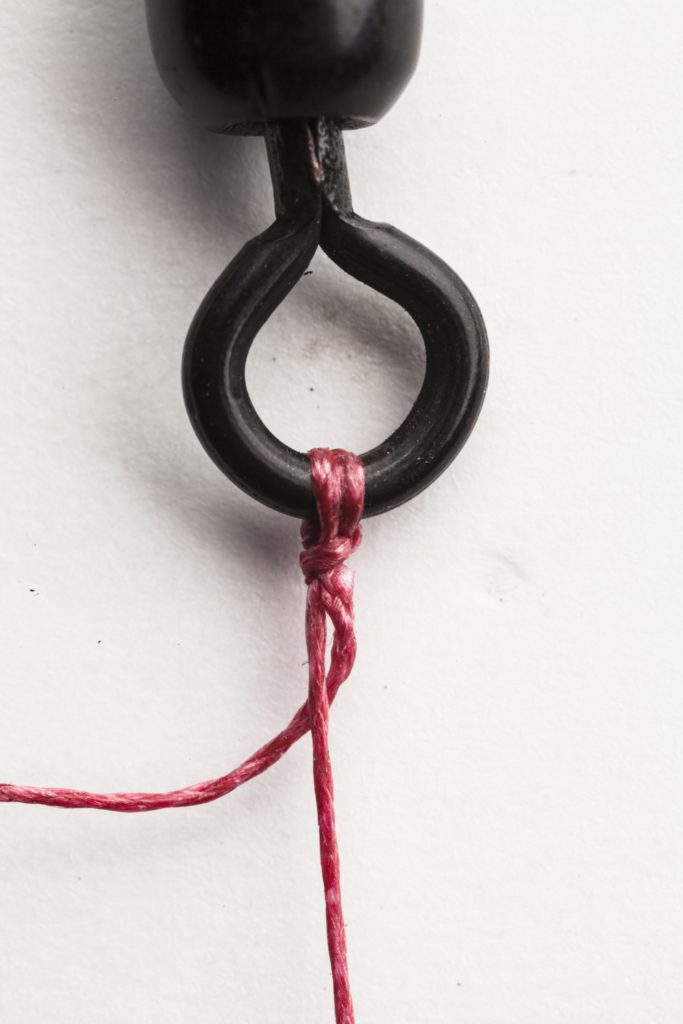
WINNING DOUBLE-LINE KNOTS
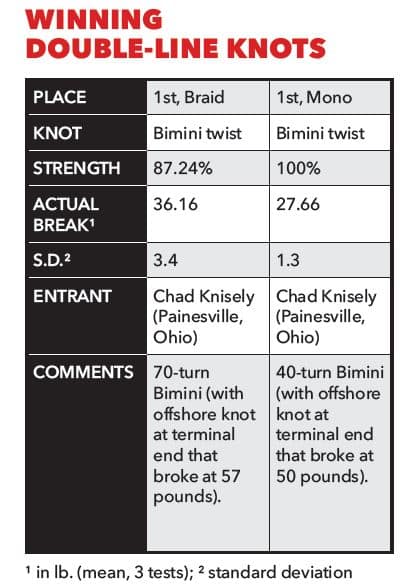
As shown in the chart, a couple of entrants opted to tie a double-line knot — a Bimini twist in both cases — and then tied their terminal knot to the swivel with the doubled line.
The terminal knots with the doubled strand of line broke at well over 100 percent in both mono and braid. That’s because these knots had twice the surface area (with two lines). In all cases, their Bimini proved the weaker of the two (and hence was counted for their break point), but still offered excellent strength.
SOME CONCLUSIONS OF THE FISHING KNOT CHALLENGE

If your preference or conditions require a single line straight to terminal gear, a variety of knots should give you more than 90 percent strength in mono, and more than 70 percent in braid.
A number of entrants tied the ever-popular uni knot. With braid, the results were pretty much all over the place, from a couple breaking at more than 70 percent, to others registered in the 60s, the 50s and — the weakest of all braid knots tested — at just 31 percent. (This means that the angler has effectively reduced his 41-pound test to merely 13-pound line. That’s a pretty huge handicap.)

The strongest uni-knot, tied by Byron Stout of Naples, Florida, and shown above, registered a respectable 74.4 percent, but used a rather complex finishing with what the entrant calls BBTIKS (Byron’s Burly Twirly Improved Knotting System); Todd Stephens’ winning palomar would certainly be quicker to tie and came out stronger in our test.
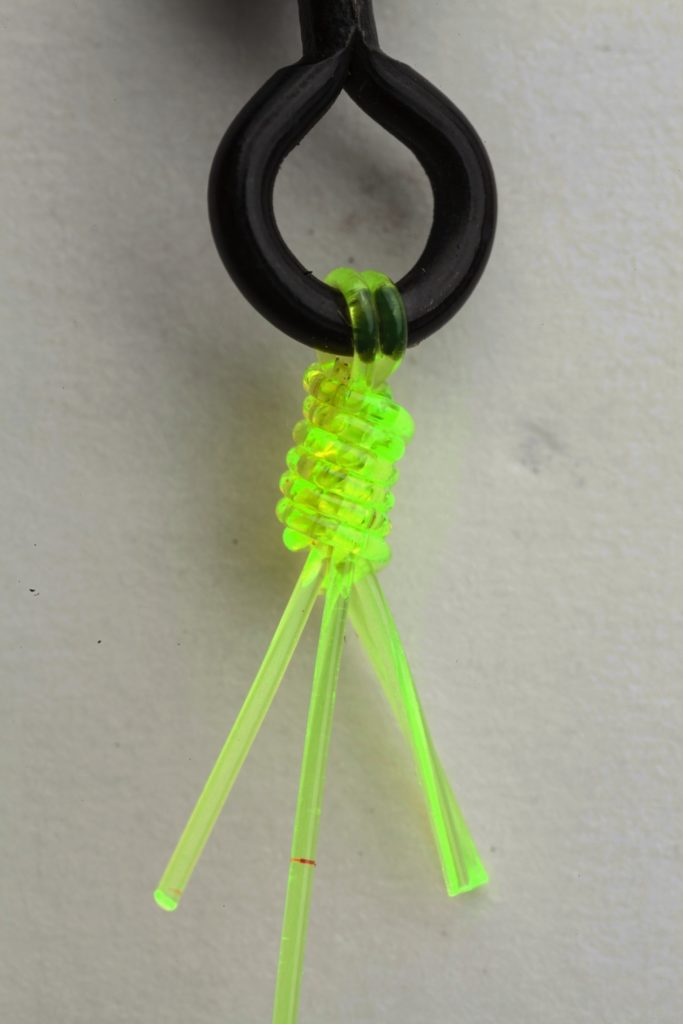
Nearly as strong in our testing (73.14 percent) was the basic five-turn uni tied by Ed Scopelitis of Mount Pleasant, South Carolina, and shown above. Yet for whatever reason, a five-turn uni tied by another entrant broke at just 31.07 percent.
In mono also, the uni varied greatly, with mean break points for the six uni entries of 87, 85, 83, 82, 75 and 73 percent.
HARD TO BEAT A BIMINI
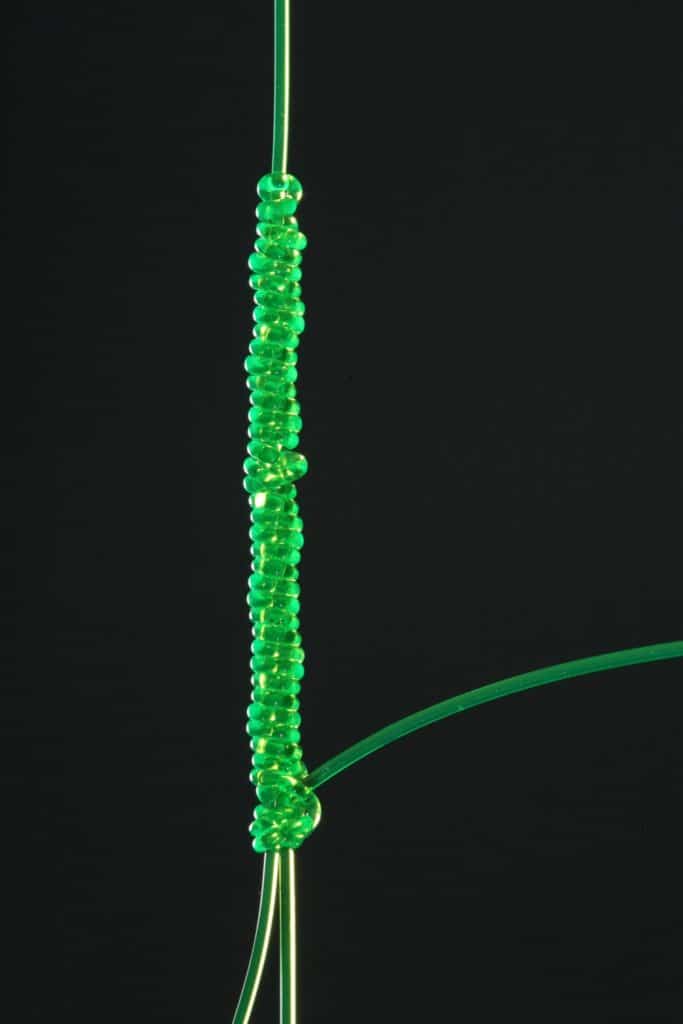
By far the most reliable approach to getting the highest knot strength seemed to require tying a Bimini twist to create a double line. Then, in fact, which terminal knot you end up using becomes almost irrelevant. A well-tied Bimini is still one of the best knots you can choose.
In mono, the Biminis offered a 100 percent knot, as good as the winning single-line terminal knot. But braid in particular benefited from this strategy.
One entrant tied a Bimini in braid that broke at about 87 percent — a good bit stronger than the best single-line braid knot (about 79 percent).
This seems to point to one pretty straightforward conclusion: Whether tying directly to your terminal gear or using a leader, you’re likely to get the greatest knot strength by starting with a well-tied Bimini twist, giving yourself a double-line loop to work with.
A NICE PAYOFF










